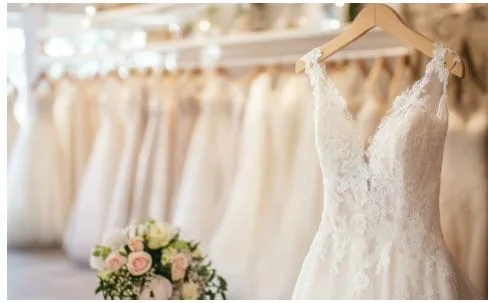A Guide to Choosing Simple Wedding Dresses for Any Season
Every bride dreams of that moment, the gentle hush before the music begins, the rustle of fabric as she steps forward, and the collective gaze of family and friends that falls on her. It’s a moment defined not by extravagance, but by emotion. And for many brides, nothing captures that authenticity better than a simple wedding dress.
Simple doesn’t mean ordinary. It means graceful, pure, and confident, a quiet beauty that doesn’t rely on sequins or layers of tulle to make a statement. A minimalist gown can be just as breathtaking as a ball gown covered in lace, perhaps even more so. Because when you strip away the excess, what remains is your story, your personality, your love.
Over the past decade, bridal fashion has seen a noticeable shift. Designers are embracing the concept of simplicity, crafting dresses that celebrate form, fabric, and feeling rather than embellishment. Brides, too, are moving away from overly ornate designs and choosing styles that reflect authenticity. Whether it’s a chic slip dress for a beach ceremony, a structured satin gown for a winter wedding, or an airy chiffon number for spring, simple wedding dresses have proven that understated beauty is timeless.
This guide explores how to choose a simple wedding dress for any season one that complements your shape, your setting, and your spirit while helping you understand what makes simplicity so powerful in bridal fashion.
Understanding the Allure of Simple Wedding Dresses
Why “Simple” Doesn’t Mean “Plain”
It’s a common misconception that “simple” equals “boring.” In reality, simplicity is one of the hardest aesthetics to master because it leaves no room to hide behind distractions. The beauty must come from the cut, craftsmanship, and confidence of the design.
A simple gown often relies on clean lines and balanced proportions. There are no heavy appliqués or dramatic layers competing for attention. Instead, your natural beauty becomes the highlight. Designers who specialize in minimalist gowns understand that elegance lies in precision: the perfect seam, the right drape, the subtle sheen of silk under soft light.
The Rise of Minimalism in Bridal Fashion
Minimalism isn’t just a fashion movement; it’s a mindset. Brides today often seek dresses that reflect their lifestyles refined, effortless, and real. As weddings become more personal and less dictated by tradition, the gown follows suit.
The 1990s slip dress revival, inspired by icons like Carolyn Bessette-Kennedy, brought minimalism to the forefront. Today’s brides reinterpret that look with new fabrics, sustainable materials, and diverse silhouettes. From city hall ceremonies to rustic outdoor vows, the modern minimalist bride values authenticity over grandeur.
The Emotional Connection Behind Simplicity
There’s something intimate about simplicity. It feels more personal, more connected. A bride in a simple gown often describes feeling “like herself” rather than playing a role. Without distractions, she’s able to focus on the emotion of the day: the vows, the laughter, the shared joy. That emotional clarity is one of the many reasons why minimalist gowns resonate so deeply.
For inspiration and examples of beautifully designed gowns that embody this effortless aesthetic, you can explore a variety of timeless options at: https://wonaconcept.com/simple-wedding-dresses/
Key Elements That Define a Simple Wedding Dress
Simplicity, when done well, feels effortless but it’s built on careful design choices. Every fabric, seam, and silhouette contributes to a refined final look. Here’s what defines a beautifully simple wedding dress.
Silhouette and Structure
The foundation of simplicity lies in silhouette. Common shapes for minimalist gowns include:
- A-line: Universally flattering and balanced.
- Sheath: Sleek and contemporary, ideal for modern brides.
- Column: Graceful and elongating, perfect for taller frames.
- Slip: Romantic and fluid, perfect for intimate settings.
The magic is in the structure. A well-cut simple gown flatters without constricting, often using internal boning or subtle tailoring to create clean, confident lines. The absence of volume doesn’t mean the absence of presence — in fact, it often commands even more attention.
Fabric Choices
In minimalist design, fabric is everything. The right fabric adds depth, texture, and light reflection. Popular options include:
- Silk crepe: Smooth and luxurious, draping beautifully.
- Chiffon: Light and ethereal, ideal for outdoor ceremonies.
- Mikado: A thicker fabric that adds structure and sophistication.
- Organza: Sheer and graceful, perfect for layering.
- Satin: Classic and luminous, a timeless bridal favorite.
Each fabric interacts with light differently matte finishes convey understated elegance, while subtle sheen adds modern glamour.
Neckline and Sleeve Designs
Minimalist wedding dresses often feature elegantly restrained necklines, think bateau, scoop, square, or halter styles. These shapes draw attention to the collarbone and shoulders, adding natural poise. Sleeves also play a key role: cap sleeves, sheer long sleeves, or even sleeveless designs can all look stunning depending on the season and mood.
A deep V-neckline might bring a hint of modern sensuality, while a high neck adds sophistication. The key is balance allowing one element to take focus while keeping the rest clean and harmonious.
Detailing Without Overdoing It
Simple doesn’t mean stark. Delicate details like a row of silk buttons, a minimalist bow, or a soft draped back can elevate a gown without overpowering it. Texture can replace embellishment, think bias-cut silk, pleats, or subtle stitching. These nuanced touches catch the light in gentle ways, making the dress visually interesting from every angle.





